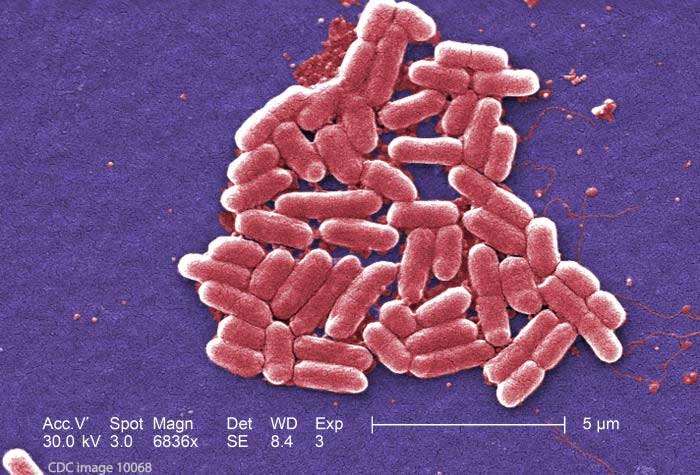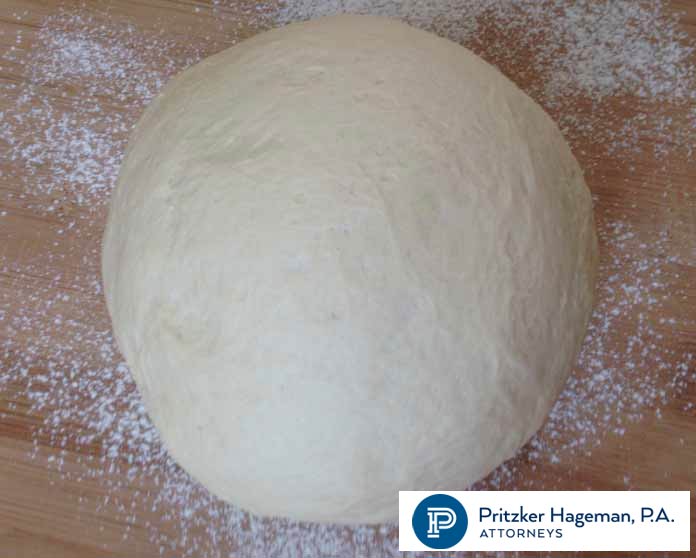Flour used at a chain restaurant is the likely source of a recent outbreak of E. coli infections and hemolytic uremic syndrome (a complication that causes kidney failure), according to the CDC.
This outbreak happened during the Gold Medal flour E. coli outbreak, but these two outbreaks are not related, according to Fred Pritzker, a food safety lawyer who helps people who have been sickened by food get compensation. The Gold Medal flour outbreak involved E. coli strains O26 and O121. This outbreak involves the more common strain O157:H7.
13 Outbreak Victims, 2 with Hemolytic Uremic Syndrome (HUS)
The CDC’s Morbidity and Mortality Weekly Report for January 27, 2017, has a synopsis of the investigation of the multistate outbreak of E. coli O157:H7 infections that were linked to restaurant pizza dough mix in 2016. Thirteen people were sickened in nine states in this outbreak, with eight of those patients hospitalized, and two people developing hemolytic uremic syndrome (HUS).

On January 4, 2016, PulseNet, the surveillance arm of the CDC, found a cluster of 10 Shiga toxin-producing E. coli (STEC) infections with the same pulsed field-gel electrophoresis (PFGE) patterns. Thirteen cases were found in nine states. The case count per state was: Iowa (1), Illinois (1), Kansas (1), Minnesota (5), North Carolina (1), Nebraska (1), New Jersey (1), South Dakota (1), and Wisconsin (1). The median age of patients was 17.
Twelve of these patients were interviewed as part of the outbreak investigation. Nine reported eating at one of the nine locations of “restaurant A,” a national chain, the week before they got sick. Eight of those nine patients ate a dessert pizza made with a proprietary dough mix from “manufacturer A.” The ninth patient ate breadsticks made from the same dough mix. Restaurant A stopped using the dough mix from manufacturer A on February 4, 2016.
CDC Says Outbreak Investigation Points to Flour as E. coli Source
Eighty-eight samples of the dry dough mix from five restaurant A locations were collected by public health officials. The restaurants were located in Illinois, Iowa, Minnesota, Nebraska, and Wisconsin.
The Minnesota Department of Agriculture identified non-O157 STEC in seven of seventeen collected samples, including one Shiga toxin-1–producing non-O157 STEC isolates and six Shiga toxin-2 (stx2)–producing non-O157 STEC isolates. In addition, the FDA collected six samples of dry dough mix from the manufacturer. All six samples tested negative for STEC O157:H7, but one yielded an stx2-producing STEC O8:H28.
The CDC states that “although no laboratory evidence identified contaminated flour as the ultimate source of this STEC O157:H7 outbreak, the identification of other enteric pathogens in multiple samples of dry dough mix consumed by patients associated with the outbreak implicates contaminated flour as the possible source of pathogen introduction for this outbreak. The small number of cases and the lack of additional restaurant clusters suggest that this was a low-level contamination event or that contamination only affected a limited amount of product.”
Another factor that could have contributed to the outbreak is that the dessert pizzas in question were made with thicker dough that may have been undercooked. If the flour used in the dough contained pathogenic E. coli bacteria, the bacteria may have survived the cooking process.
Can People Sickened by Contaminated Flour Sue for Compensation?
Yes, if you are part of this outbreak linked to chain Restaurant A, you can sue for compensation. Your lawsuit can seek money for medical bills, future medical expenses, lost income, pain and suffering, emotional distress and other damages.
If you were part of the E. coli outbreak linked to Gold Medal flour, you can sue General Mills for compensation.
Avoid Raw Flour
Flour is a raw agricultural product that does not undergo a kill step to kill pathogens before it is put into commerce. This means any E. coli bacteria in the flour was not killed before it was packaged for sale to consumers like you.
This outbreak and the one linked to Gold Medal flour serve as reminders that processors, retailers, and restaurants should consider that flour may be contaminated with pathogens and can pose a health risk.
Do not eat raw or undercooked dough or batter, and handle flour carefully.
The symptoms of an E. coli O157:H7 infection include severe abdominal cramps, watery and/or bloody diarrhea, a mild fever, and possible nausea or vomiting. These symptoms usually occur 3 to 4 days after exposure to the bacteria but may occur as long as 10 days later.
The symptoms of hemolytic uremic syndrome (HUS) include little or no urine output, lethargy, a skin rash, easy bruising, and bleeding from the nose or mouth. Anyone experiencing these symptoms should see a doctor immediately.
A similar outbreak happened in 2009 when cookie dough was implicated in an outbreak. At that time, we let people know that E. coli victims should not be blamed for an outbreak.
Contact Our Law Firm for a Free Lawsuit Evaluation
If you ate dessert pizzas in the states listed above and experienced the symptoms of an E. coli O157:H7 infection, contact our experienced attorneys for legal help. As stated above, if your case can be connected to “restaurant A” with epidemiological or microbiological evidence, you may be able to sue for compensation.
